
Parlophone Label: Compilation Albums
#20. Love Songs (PCSP 721)
(Update: 28th. March 2017)



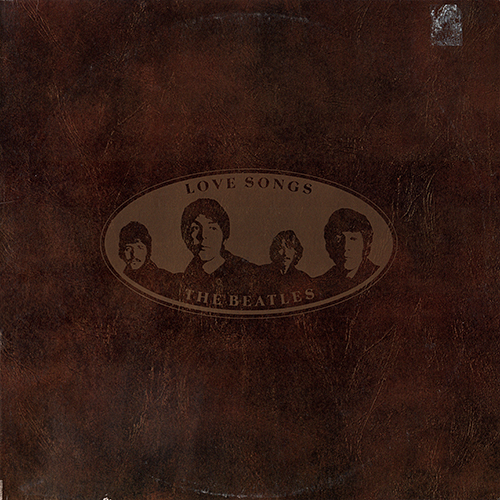 Parlophone 1st. Sleeve |
|
TITLE
|
LOVE SONGS |
||||
| CATALOG NUMBER | PCSP 721 |
||||
|
RELEASE DATE
|
19th. November 1977 / First Press |
||||
| TRACK LISTING | SIDE 1 | SIDE 2 | |||
| Yesterday |
Something |
||||
| I'll Follow The Sun |
And I Love Her |
||||
| I Need You |
If I Fell |
||||
| Girl |
I'll Be Back |
||||
| In My Life |
Tell Me What You See |
||||
| Words Of Love |
Yes It Is |
||||
| Here, There And Everywhere |
|||||
| SIDE 3 | SIDE 4 | ||||
| Michelle | The Long And Winding Road |
||||
| It's Only Love |
This Boy |
||||
| You're Going To Lose That Girl |
Norwegian Wood |
||||
| Every Little Thing |
You've Got To Hide Your Love Away |
||||
| For No One |
I Will |
||||
| She's Leaving Home |
P.S. I Love You |
||||
| FRONT --> Click! | BACK --> Click! | INSIDE |
DISK | ||
 |
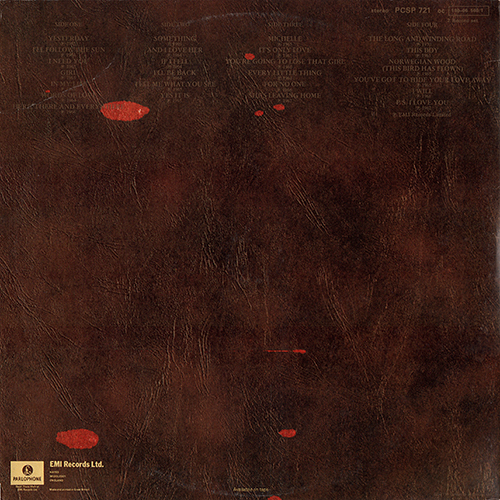 |
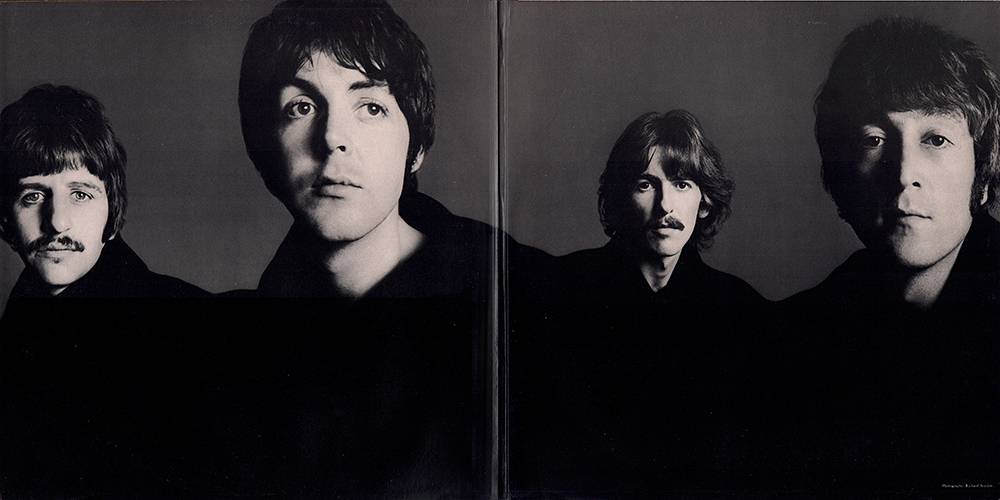 |
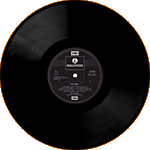 |
||
| SIDE 1 --> Click! | SIDE 2 --> Click! | SIDE 3 --> Click! | SIDE 4 --> Click! | INNER SLEEVE | |
 |
 |
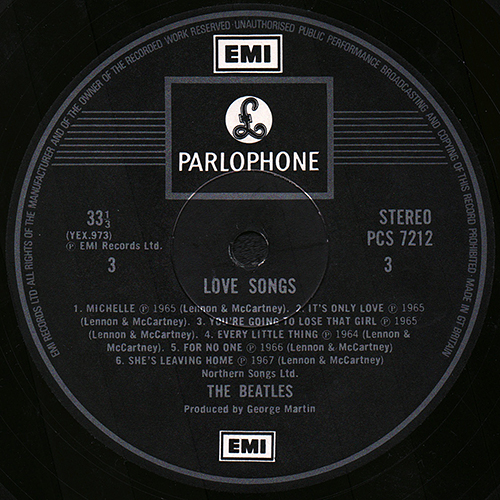 |
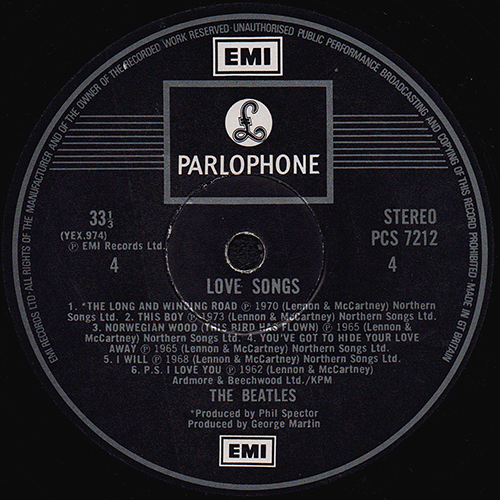 |
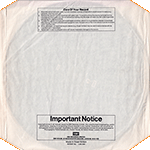 |
|
| BACK COVER CLOSE UP |
|||||
|
|
 |
||||
| Unlaminated
gatefold sleeve with leather texture effect was manufactured
by Garrot & Lofthouse Ltd. "Parlophone" logomark was printed at the left corner of the back cover. |
|||||
| INSIDE CLOSE UP | LABEL CLOSE UP | ||||

|
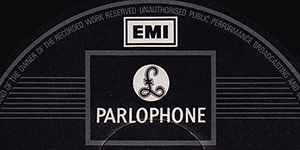 |
This label have two "EMI" marks, which are white with black print (reversed). | |||
| Photographer's
credit
"Richard Avedon" was printed at the right corner of the
inside cover. |
|||||
| LABEL CLOSE UP | |||||
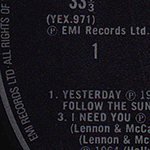 |
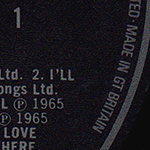 |
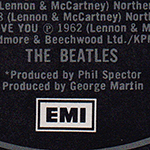 |
"EMI RECORDS LTD." printed at the start perimeter print and "MADE IN GT. BRITAIN" printed at the end of the perimeter print. |  |
|
| First matrix numbers: Side 1:
YEX 971-1 Side 2: YEX 972-1 Side 3: YEX 973-1 Side 4: YEX 974-1 |
|||||
| OTHER ITEM | |||||
| - |
|||||
| LABEL | Silver Parlophone label Two EMI Marks Type-3 | ||||
| MIX | STEREO | ||||
| MATRIX No. | SIDE 1 | YEX 971-1 | |||
| SIDE 2 | YEX 972-1 | ||||
| SIDE 3 | YEX 973-1 | ||||
| SIDE 4 | YEX 974-1 | ||||
| VINYL COLOR | BLACK | ||||
| RECORD COMPANY'S NAME | Label:EMI Records Ltd. Album Cover: EMI Records Ltd. |
||||
| CENTRAL REMARK "SOLD IN U.K." |
- | ||||
| RECORDING PUBLISHED CREDIT | (P) 1962 1964 1965 1966 1967 1968 1969
1970 1973 |
||||
| COVER FORM | Unlaminated gatefold sleeve with leather texture effect | ||||
| PRINTER CREDIT | - (Printed by Garrod and Lofthouse Ltd.) | ||||
| COVER DESIGN/ PHOTO/ NOTES | Photography: Richard Avedon Art Director of Capitol records in the U.S.: Kenneth R. Anderson |
||||
| INNER SLEEVE | White paper sleeve "IMPORTANT NOTICE in
rectangle box" Type-1-2 printed in black ink / Phonographic Performances Ltd. address: Evelyn House |
||||
| PRODUCER | George Martin | ||||
| COMMENTS | The second E.M.I. compilation double album
to appear after the contract expiration, and this time a
contrived title, particularly to appeal to the Christmas
romance market. The package of this release has the catalogue number PCSP 7212, but the two albums are individually numbered as PCS 7211 and PCS 7212 The album was also released on cassette tape, Catalogue number - TC2 PCSP 721. As with the "Red" and "Blue" albums, and the "Rock'n'Roll Music" release, the presentation of this package was once again minimal, especially for the U.K. market. The artwork was dramatic but really only comprised of one excellent picture. There were, as usual, no "special" tracks, no lyrics, no coloured bags, no information, and just that one picture within the gatefold sleeve. For the gatefold sleeve used the famous collage of photos taken by Richard Avedon August 11, 1967 in London. This album is mainly a compilation of tracks previously available on the other Beatles albums. The only two not previously issued on British albums are gThis Boyh and gYes It Ish and these are simply mono recordings re-channelled into fake stereo, even though gThis Boyh is available in stereo on a Canadian single. Although the British format was pretty cheap looking, readily available on Import was a "Gold Vinyl" edition. This came out in August 1978 on Capitol with a catalogue number of SEBX 11844. This has a much thicker sleeve, designed to feel more like leather, with gold embossed front design, and lettering on the rear, plus special inner sleeves. First pressing: Black label with two white-black EMI logos and silver print. gThe EMI Records Ltdch printed at the start perimeter print and gMade In GT. Britainh printed at the end of the perimeter print. Matrix numbers: Side 1: YEX 971-1; Side 2: YEX 972-1 (or 2); Side 3: YEX 973-1 (or 3); Side 4: YEX 974-1. Second pressing 1981 ? 1984 Black label with two white-black EMI logos and silver print. gALL RIGHTS OF THE PRODUCERch printed at the start perimeter print. Importantly, around the 11 eof clock position in the rimtext the wording is: gcUNAUTHORISED PUBLIC PERFORMANCE, BROADCASTING, COPYING AND HIRINGch. Instead, added gMANUFACTURED IN THE UK BY EMI RECORDS LIMITEDh text at the end of the perimeter print. Matrix numbers: Side 1: YEX 971-1 (or -2); Side 2: YEX 972-2; Side 3: YEX 973-3; Side 4: YEX 974-1 (or -2). Third pressing, 1984 until 1987 Black label with two white-black EMI logos and silver print. gALL RIGHTS OF THE PRODUCERch printed at the start perimeter print. Importantly, around the 11 eof clock position in the rimtext the wording is: gUNAUTHORISED COPYIN, HIRING, RENTING, PUBLIC PERFORMANCE AND BROADCASTINGch. gMANUFACTURED IN THE UK BY EMI RECORDS LIMITEDh text at the end of the perimeter print. Matrix numbers: Side 1: YEX 971-2; Side 2: YEX 972-2; Side 3: YEX 973-4-1-1-1; Side 4: YEX 974-2. Unlaminated gatefold sleeve with leather texture effect was manufactured by Garrot & Lofthouse Ltd. According to JPGR, "Story Of The Album Design" The packaging for this set was designed by the then Art Director of Capitol records in the U.S. - Kenneth R. Anderson. Mr. Anderson contacted JPGR and supplied the photographs you see below and the explanation for the iconic gatefold picture is in his own words: "At Capitol Records, I'd been given the assignment to create a deluxe package for a new Beatles double l.p. set. With Christmas 1977 approaching, Capitol was swinging for the bleacher seats: 25 mushy tunes that Grandma could love. But they were all songs everyone already owned, nothing new was being offered, just a potentially fancy package. For the inside double spread, I'd sold The Powers That Be on the use of an iconic Richard Avedon photo. It had been seen in 1968 in LOOK magazine in the U.S. and in STERN in Europe. Not the individual psychedelic color photos, but the iconic 4-page fold-out, b&w group panorama... known as "Mount Rushmore". Just one hitch: Paul was in the original photo, but was hiding in the lower left corner, about half John's size. Now I had to persuade Avedon to not only to sell us the photo, but to allow us to tear apart & rebuild his famous image so Paul would be more equal than the others. (Paul was the only ex-Beatle still on Capitol, in Wings, and would be touring the U.S. as part of Capitol's incentive ). "Send me a layout." Avedon simply agreed, and now I knew why. Unlike Robert Freeman's photo for "Meet the Beatles," Avedon's well-known portrait was actually four individual photos that had been stitched together. That's why everyone was in focus regardless of size or position; it wasn't just Avedon's famous large-format 8x10 view camera. In the dark confines of a hooded lucigraph, I drew my composition actual size on tracing paper. The cloak they were wearing had a huge collar. I tried to maintain the overall rhythm of the original version, allowing space for the album's gatefold. My detailed sketch was shipped to New York. In the years before Photoshop and the internet, the combination print process was slow and cumbersome. Avedon's print eventually arrived with the four photos exposed independently on a large white sheet, as per my drawing. The airbrush retouching job was given to Alan Williams, who followed my indication for silhouetting their shoulders. A gray background blended & united the overall image. Some of the airbrushing was done on the print, some on an acetate overlay. Paul was now the leader of the pack, slightly bigger than John and above him. It was a new & improved Mt. Rushmore. I developed a graphic version from successive exposures of the art onto litho film. Those were painstakingly matched, cut & pasted together using the best parts to create a final high-contrast icon. I actually created two: one for positive reading uses, another for reversing out of dark backgrounds. The second version was used for the front cover: a gold foil oval stamped on a simulated rich leather album. That rich leather was really a piece of tan textured cover stock I got from McManus & Morgan on 7th Street. On the asphalt of the Capitol Records parking lot, I sprayed the paper with Burnt Sienna and Burnt Umber paint. After the cover was printed, it was embossed with texture, like a discount fake oil painting reproduction. Fancy. The complete package included an 11" x 11" booklet with calligraphy-style lyrics on simulated parchment paper. Michael Manoogian did the lettering, and the parchment look was a 2-color photographic fake. A limited run of lps were pressed on gold (yellow) vinyl. For the Rolling Stone ad, I rented some props from Western Costume on Santa Monica Blvd. and shot it all on velvet. I'd broken The Lads up, but they were together again. The L.P. did fine for Christmas and stayed on the Billboard charts for 31 weeks, eventually selling 3,000,000 units. The compilation was deleted from the catalog in the late 1980s. |
||||
